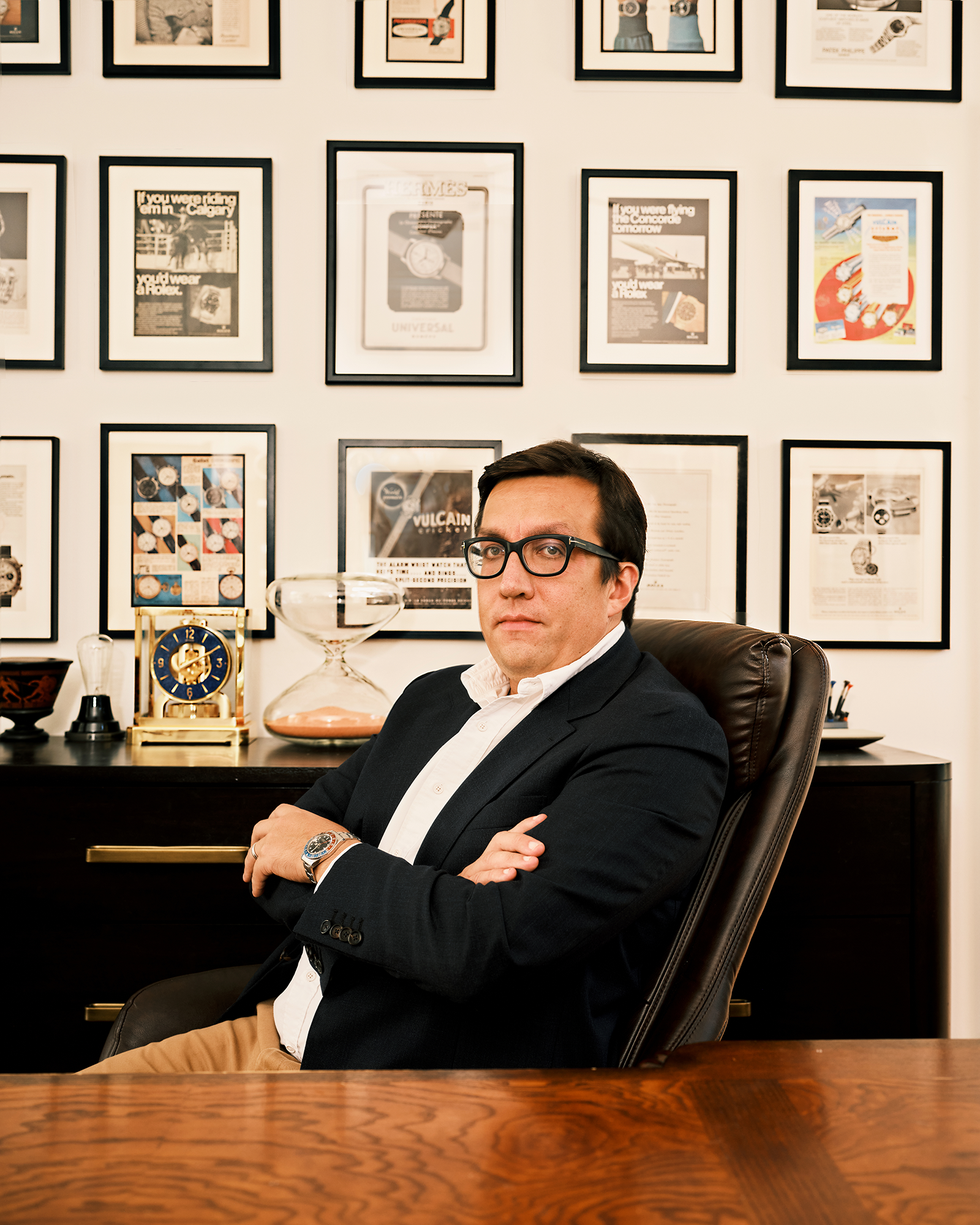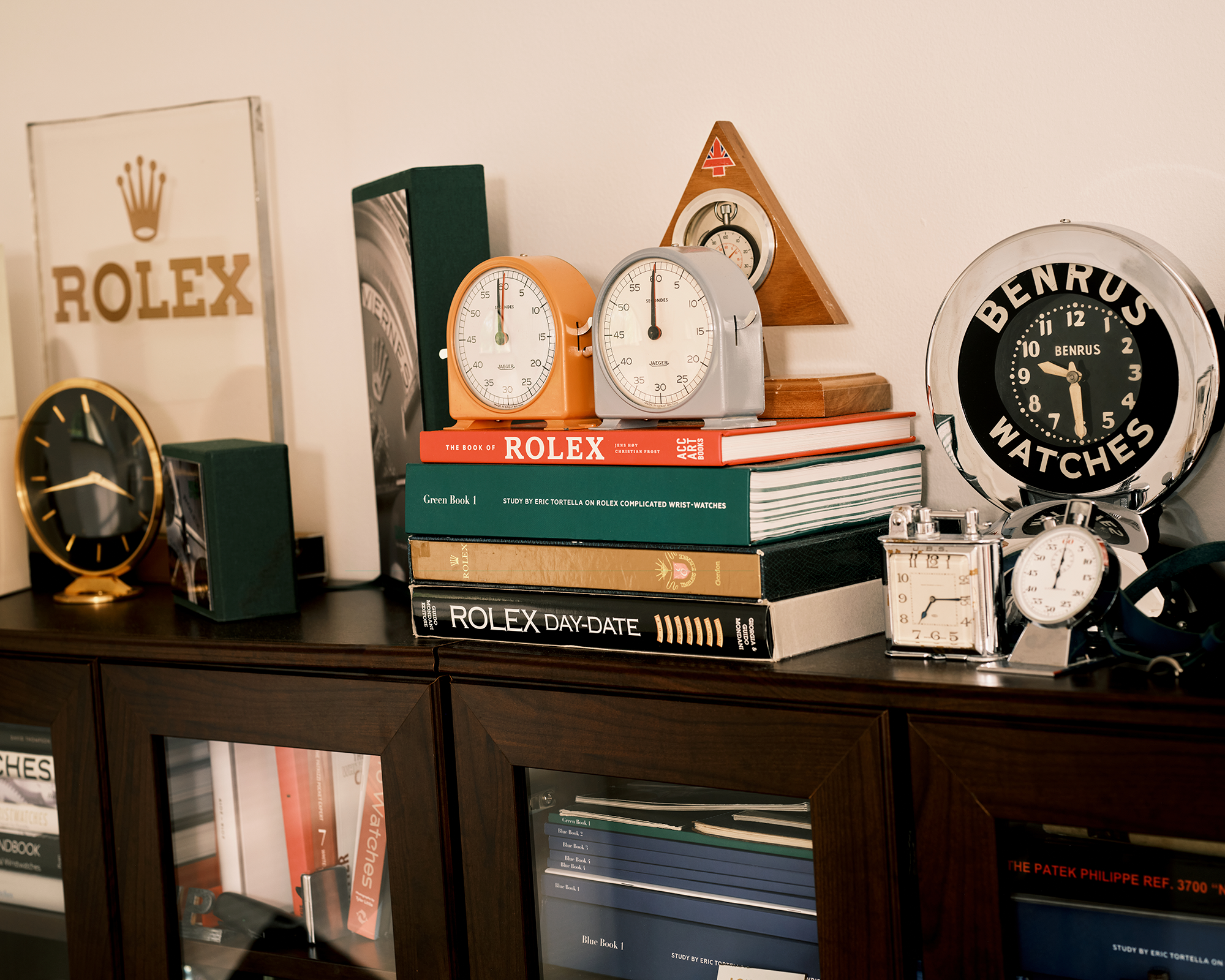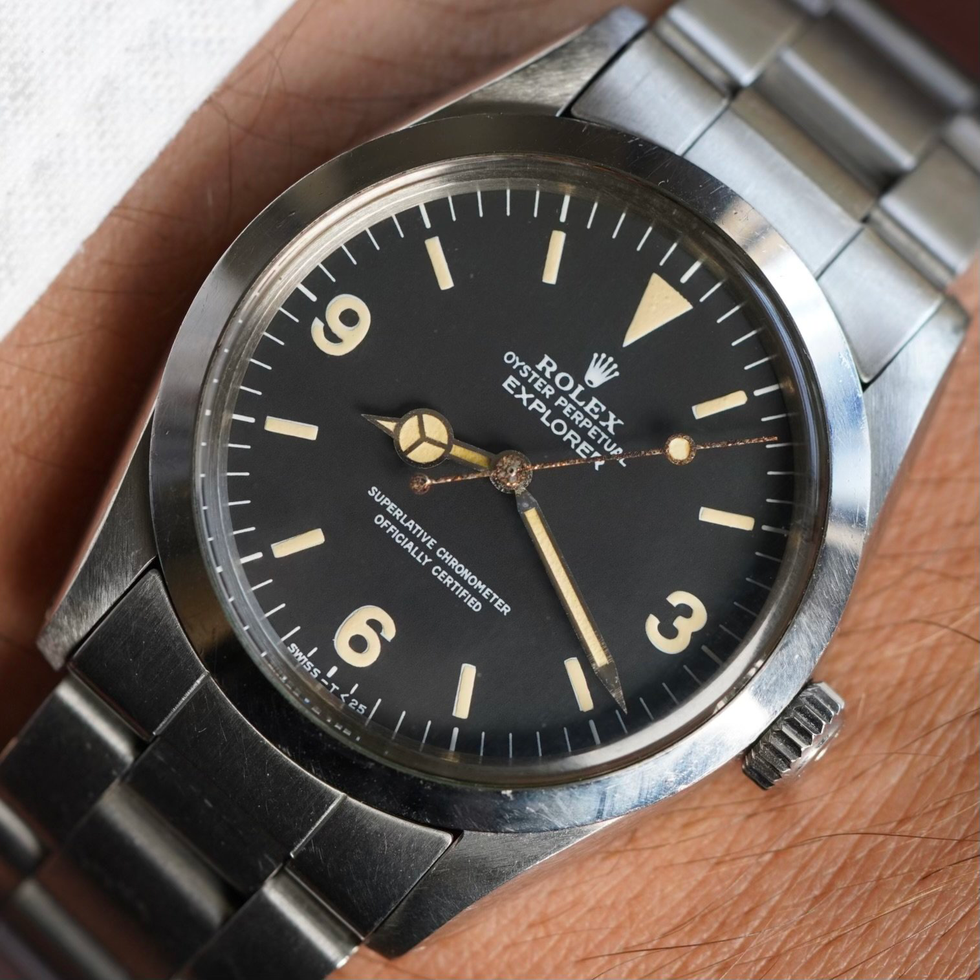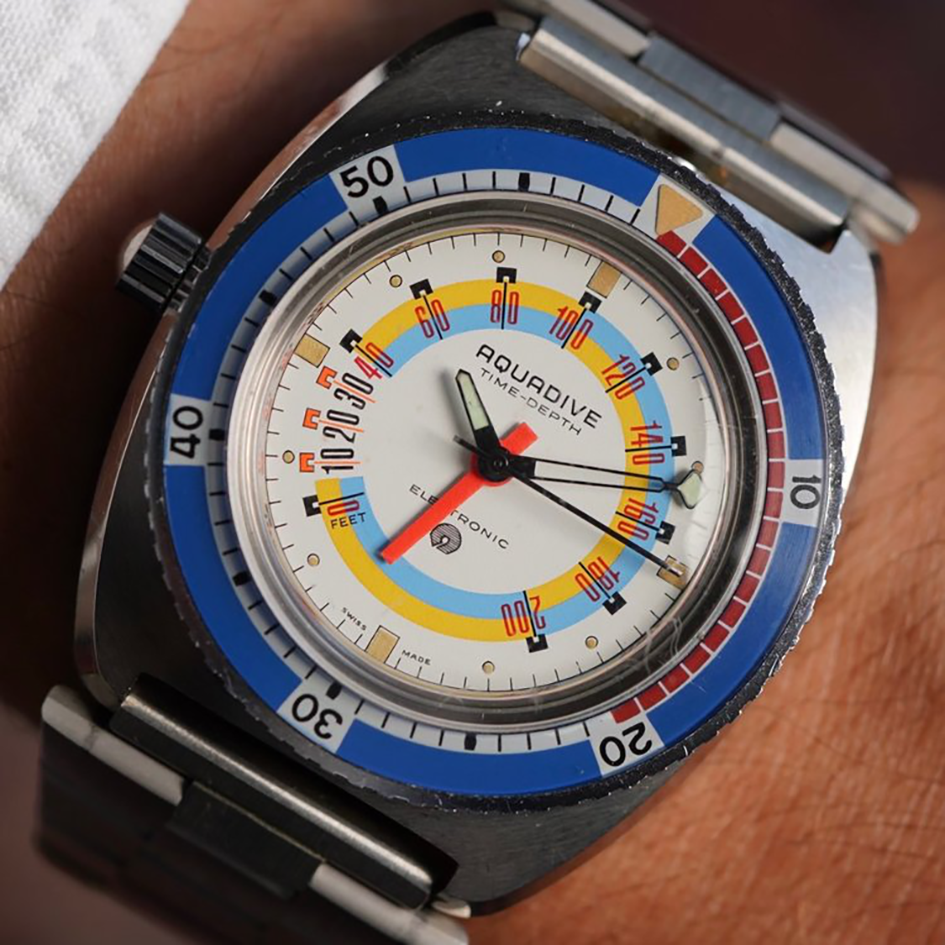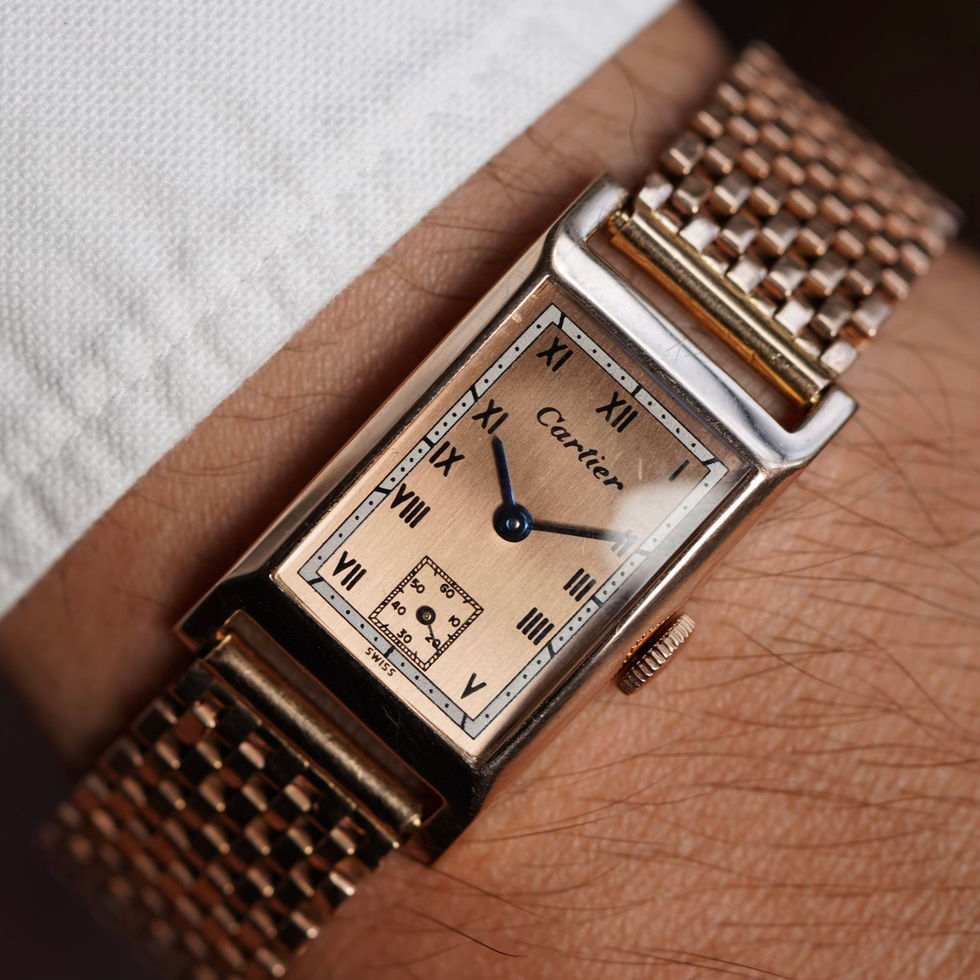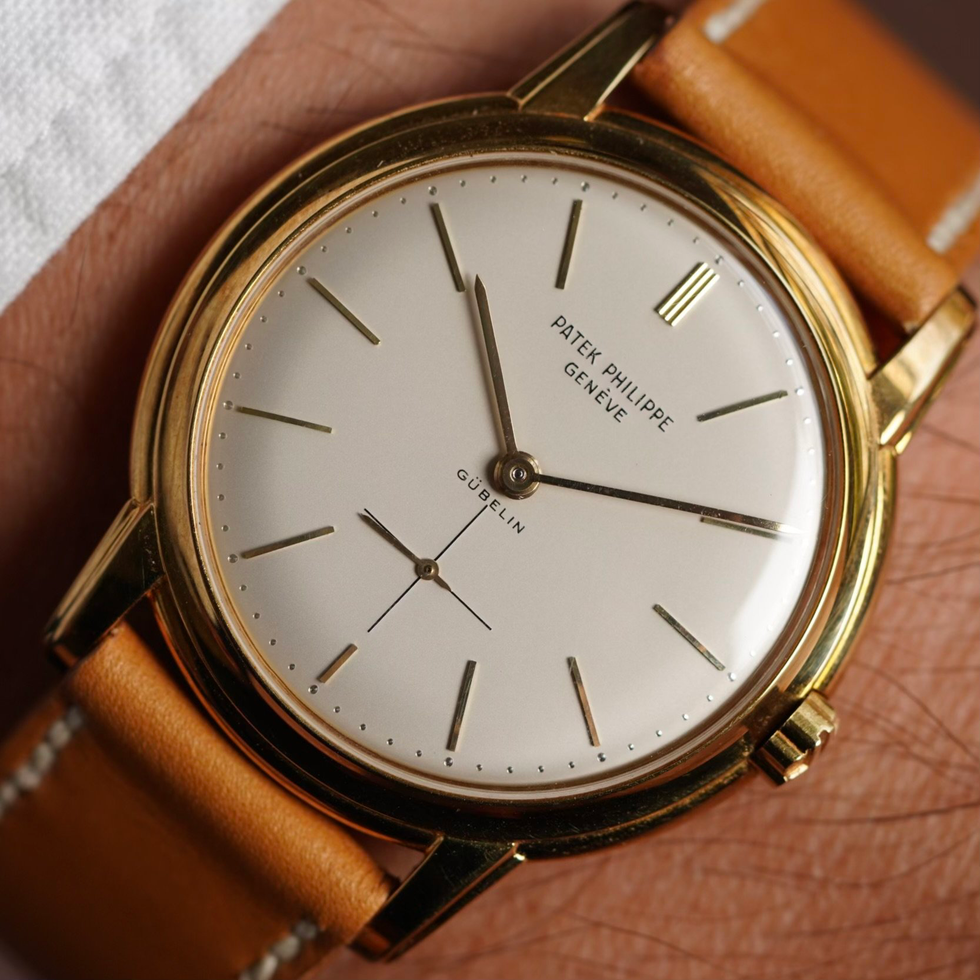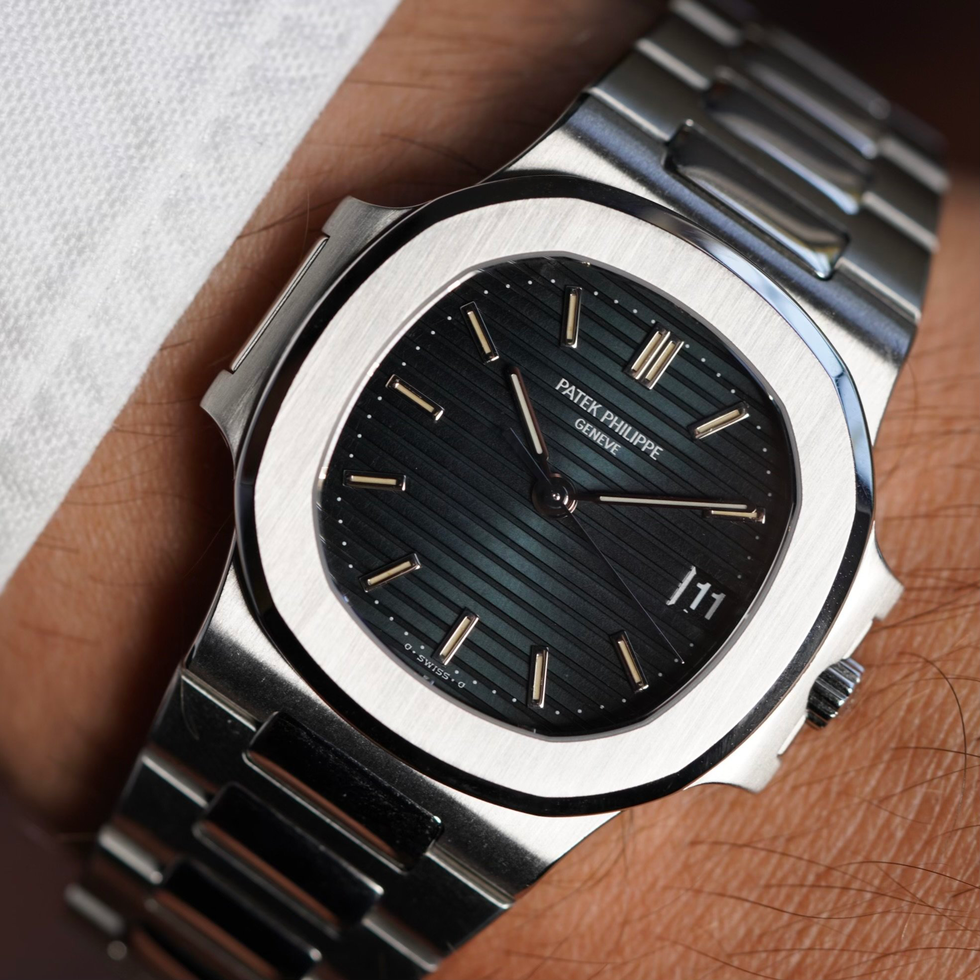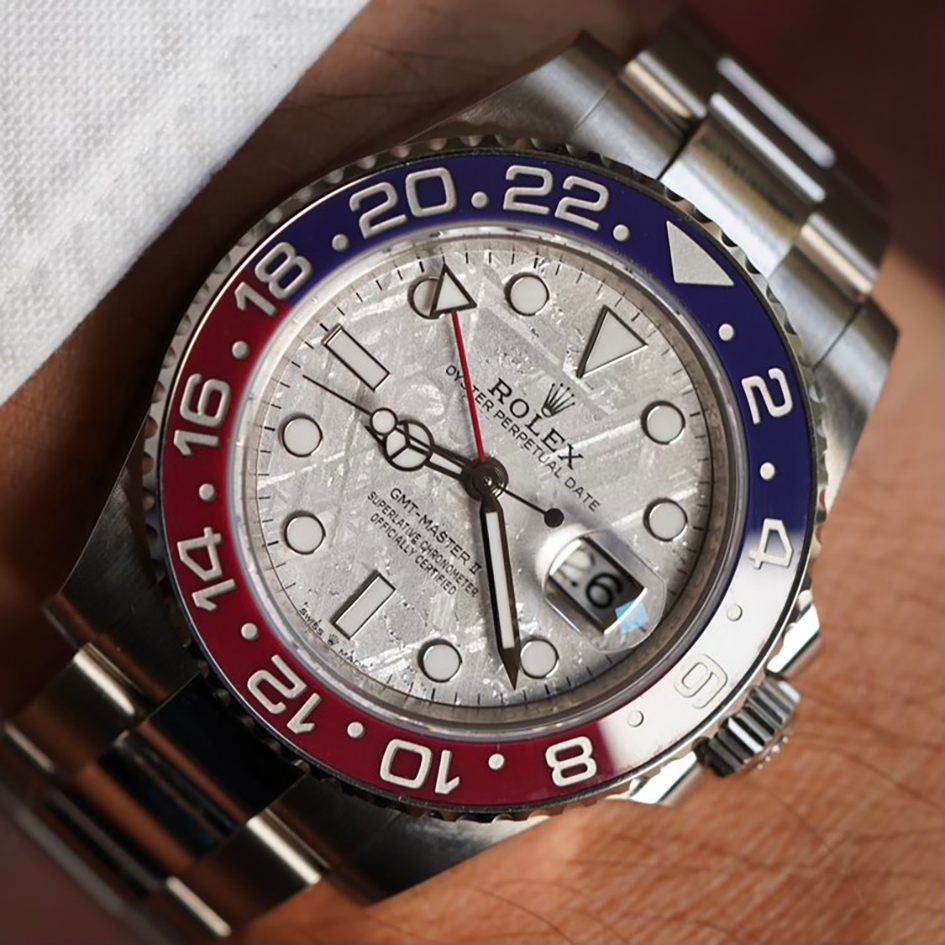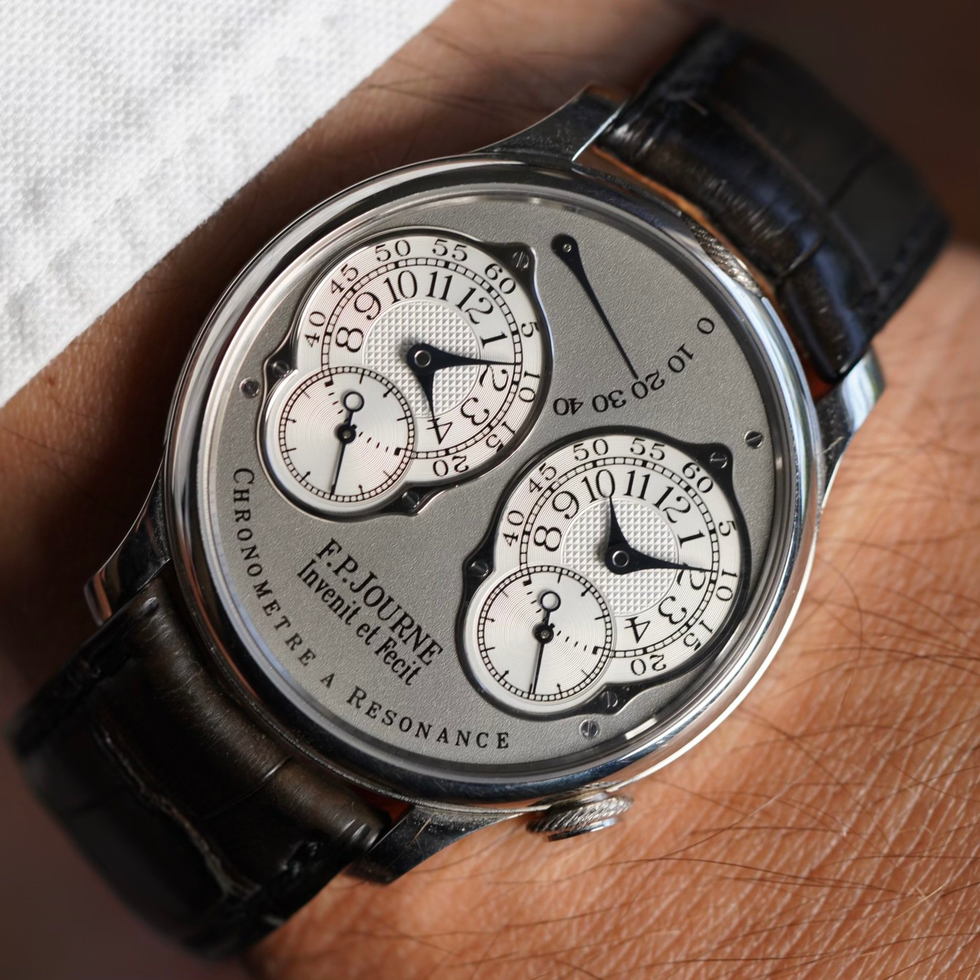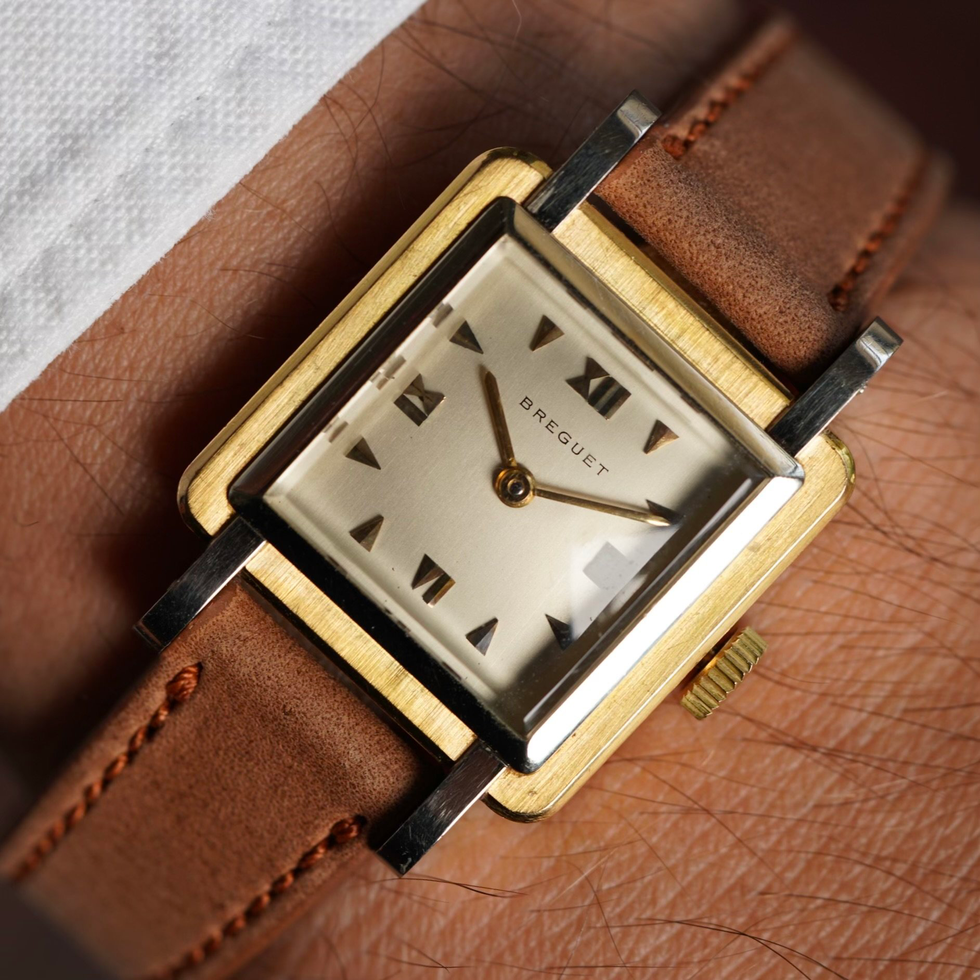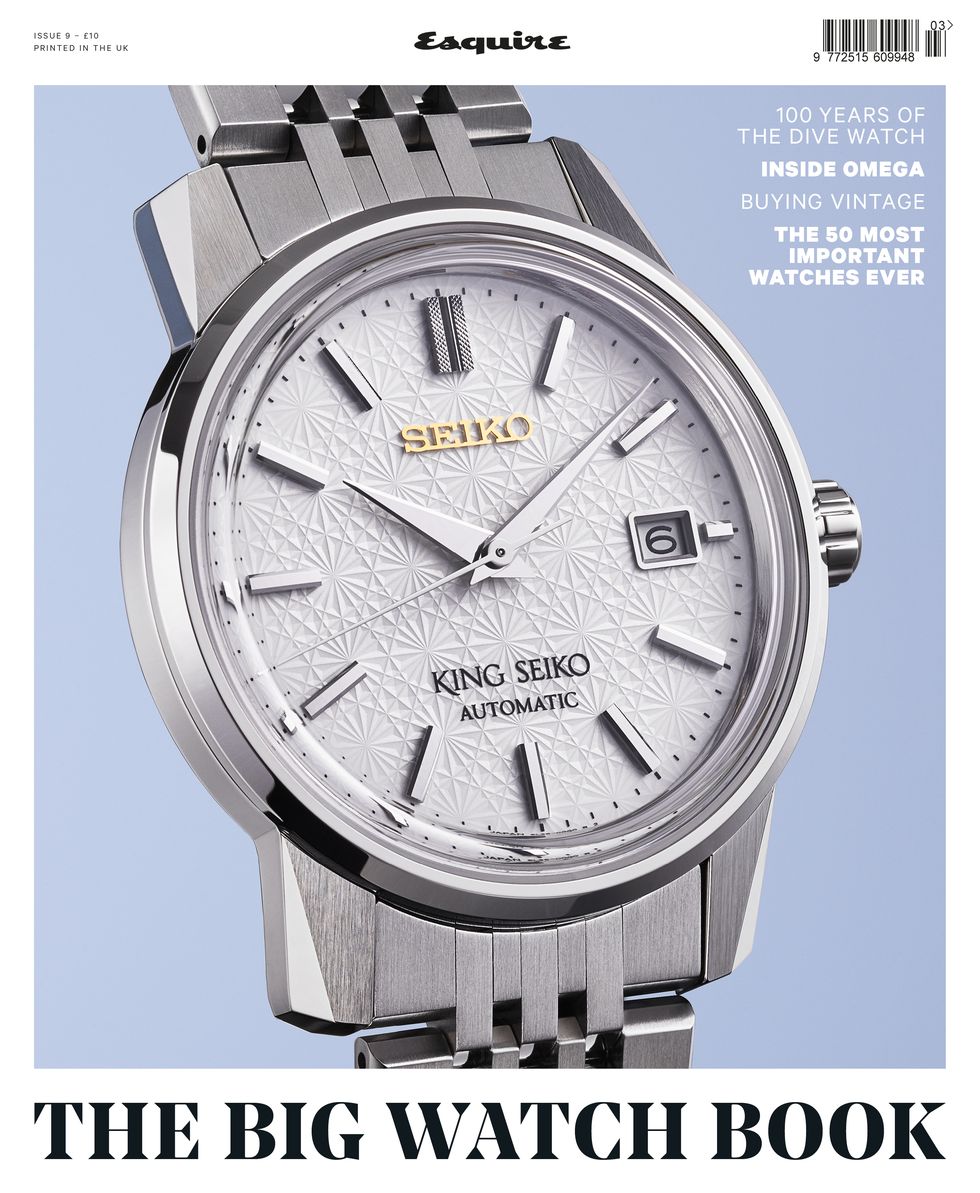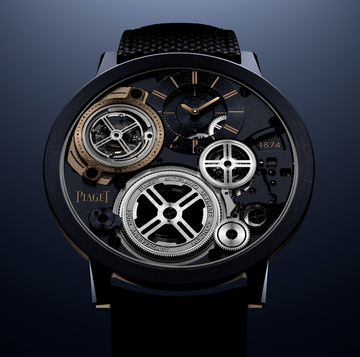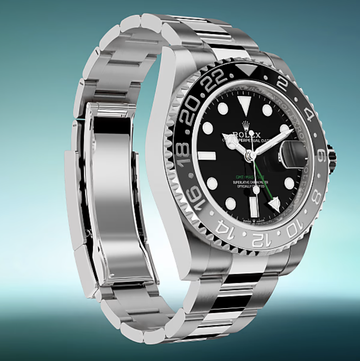“And this,” said Eric Wind, “belonged to Spencer Tracy.”
Wind reached for a ziplock bag and pulled out the watch — a Rolex Explorer, reference 6350, from 1955 or 56, that was once owned by the Hollywood star: a perfect example of its type.
The Explorer is a classic Rolex sports watch, and was favoured by mountaineers at a time when mountaineering was very much in the news, following Edmund Hillary and Tenzing Norgay’s conquest of Everest in 1953.
In 1956, Wind explained, Tracy had starred in a movie, The Mountain, in which he played a skilled climber on a rescue mission on Mont Blanc. Whether the decision for Tracy to be filmed wearing the Explorer was the result of an astute property master on the film, or canny product placement by Rolex, one way or another this was the watch that Tracy wears in the film. Wind can confirm this, having watched The Mountain “several times” and found posters for the film that clearly show the watch on Tracy’s wrist.
Wind passed it to me: “Here, put it on.” That model of the Explorer would usually have been sold on a bracelet, but the watch had a leather strap. Hillary and Norgay chose leather, he said, because of the freezing temperatures on Everest. This was the strap Tracy would have attached to his wrist. I felt I had put on a piece of history. “I think it suits me,” I said. Wind laughed and held out his hand for me to give it back to him.
Since founding his company Wind Vintage six years ago, Eric Wind has established himself in the vanguard of collector-dealers in vintage watches.
His lectures at the Horological Society in New York have drawn the biggest audiences in that institution’s history, while his videos and articles on the watches website Hodinkee are models of scholarship and the whys and wherefores of collecting vintage watches, drawing tens of thousands of viewers.
Wind loves vintage watches. Really loves them. It requires only a short acquaintance to see that they are not so much a passion as an obsession. It’s possible nobody knows more on the subject than Wind, and what he doesn’t know isn’t worth knowing. What he does know is worth hundreds of thousands and, on occasion, millions of dollars.
“Charlie and I spend way too much time looking at watches, reading about watches, learning about watches,” he says, referring to Charlie Dunne, senior watch specialist at Wind Vintage. “I still have sleepless nights when I have an exciting watch coming to me; it doesn’t even have to be expensive, but exceptional in terms of condition.”
He had recently taken delivery of a “very cool” Vacheron Constantin from 1983, in superb condition, with original box and papers.
“It was under $10,000, found in a safe-deposit box — this gentleman’s mother or grandmother had passed away. A friend contacted me to ask if I’d be interested, and I was like, ‘Wow, just the condition, the configuration’ — I’d never seen this exact watch before.”
It posed a familiar problem. Wind was a collector before he was a dealer and, after acquiring any watch, he finds himself engaged in a struggle between desire and pragmatism — should it stay, or must it go? Happily for his bank balance and the welfare of his wife, Christine, and three young children, pragmatism usually triumphs.
He had got the Spencer Tracy Explorer (my wrist felt strangely naked without it) from a small auction house. He could have put it on his website and caused a feeding frenzy, he said, but a couple of his regular clients were interested, and one of them ended up buying it.
Wind is 37, an affable man dressed in white chinos, a polo shirt and a pair of Nike sneakers, with smiling eyes behind Tom Ford glasses.
He works out of an office in Palm Beach, Florida. Outside the sun was blazing close to 40°C, but inside the air-con was set to a comfortable, vintage-watch-friendly temperature. There was a large desk where Wind has his laptop, and a smaller one for Dunne. Security cameras and alarms winked and squawked.
Wind deals in a range of vintage watches — Omega, Heuer, Patek Philippe and others, but the majority of his business is buying and selling vintage Rolex. Not only is Rolex one of the most respected luxury brands in the world, he says, the watches are also technically superb. Rolex was one of the first companies to promote the self-winding automatic watch, in the early 1930s, and its Oyster case provides a matchless protection against water and dust. Thirdly, because Rolex is privately owned by the Hans Wilsdorf Foundation (which is a registered Swiss charitable foundation and pays lower tax), it has maintained production at a consistent level — the company is secretive about numbers but estimates generally put it at just over 1m watches a year — which has retained brand perception and values on the secondary market.
Rolexes dominate Wind’s personal collection — Explorers, a Submariner, a GMT-Master, a Daytona, a Datejust. When we met, he was wearing an Explorer — “a simple, humble watch from circa 1985, just in fantastic condition”.
His collection also includes Patek Philippe and a number of Vulcain Crickets, an attractive dress watch with an alarm movement, dating back to the 1950s. “It’s stuff that I absolutely love,” he says. “I try not to have anything in my personal collection that’s above $100,000. Much of it is $50,000 and under. My bar is if it hurts my heart it’s hard to part with it, but sometimes you have to.”
He also collects ephemera — boxes, advertising brochures, store cards and signs. Dunne brings out a ruler and pencil sharpener bearing the Vulcain name and the slogan: “The reminder on your wrist that rules your busy day.” “It’s probably the only Vulcain ruler and pencil sharpener on the planet,” Wind says with a laugh. “It’s very Mad Men-esque, all this stuff. Some of it is rarer than the watches.”
Wind is the son of an optometrist father and a wedding-photographer mother and grew up in Wisconsin. Almost every collector, he says, has their “Rosebud” watch — the one that carries with it the poignant scent of childhood that stays with them for life. His was a GI Joe, Casio-style digital watch — “it had a compass in the khaki-green rubber strap” — that his mother gave him when he was five. He threw it away in his teenage years, but recently bought another on eBay, “new in the package. It was under 20 dollars…”
In 2008, when Wind was 22, he inherited his grandfather’s watch, a 1947 Hamilton, called the Neil. “Very simple, made in Pennsylvania, a gold-filled watch, with beautiful Breguet-style numerals, an Americanised version of the numerals designed by Louis Breguet in France in the late 18th/early 19th century.” It was the start of a love affair.
He went on to study politics and international affairs at Georgetown University in Washington, and did an MBA at Oxford before working for a biofuel venture in Florida. By now he had started writing articles for Hodinkee, exploring the history of different watches, brands and trends in the auction world. The articles were noticed by John Reardon, Christie’s International Head of Watches, who in 2014 contacted Wind to ask if he would be interested in joining the auction house, and in 2015 Wind quit his job and took up the offer.
It was to be an education in the art of the market, convincing owners to consign their watches to Christie’s rather than to another auction house, and in the art of selling.
In 2017, Wind and Christine set up Wind Vintage, which has grown to become one of the most-respected vintage-watch dealers in the world, not only selling from his website, windvintage.com (on track for more than 700,000 unique visitors this year — 10 times the number from just two years ago) and in recent times also selling through high-end fashion retailers Kith and Dover Street Market.
The term “vintage” generally applies to any watch dating back to the 1980s and earlier. For Wind — as, he says, for so many collectors — the fascination for mechanical watches lies in the thrill he felt when he was given that 1947 Hamilton as a young student.
“My grandfather was given the watch by my grandmother for their wedding. He wore it basically every single day since then, apart from when it was being serviced. So I wore it and I became fascinated by the idea that this object was mechanically telling the time. For my generation, everything in our lives is battery-powered or plugged in, so having something mechanical was mind-blowing to me.”
The growing interest in vintage watches, he says, can be traced back to the so-called “quartz crisis” in the 1970s and early 80s, which saw the mechanical watches made in Switzerland giving way around the world to the new electronic watches being produced by Japanese companies such as Citizen, Seiko and Casio.
“The common phrase nowadays is: ‘No one needs a watch to tell the time.’ You can go to your local pharmacy and buy a $10 watch that’s more accurate than anything mechanical.”
But what a mechanical watch offers is craftsmanship, prestige, history — and endurance. “A great mechanical watch in my view should last 500 years. There’s not much else in our world that will last that long, unless there’s an important reason to preserve it.” Depending on the model, of course, vintage watches can also be “the most valuable per-square-centimetre objects in the world outside of diamonds” — which are also forever. “It’s kind of an anachronism that people are interested in mechanical watches today, and there’s so much desirability and interest in them, but certainly I’m happy there is.”
Wind estimates that the vintage-watch market is worth “several billion dollars”. “There’s far more transaction value on the secondary market than there was five to 10 years ago. It’s estimated the Swiss watch industry is worth around $25bn a year, and in a few years the secondary market will be $32bn, so it’s overtaking the industry itself.” He notes that eBay has invested heavily in the authentication of vintage watches (“they sell probably over $1bn in watches”), while the website Chrono24 is valued at around the same figure. Instagram has also played its part. “With Instagram, almost anyone with an iPhone can become a watch dealer,” Wind says. Whether you can trust them or not is another matter, of course.
The primary consideration in collecting, Wind says, used to be rarity. Now it’s “condition, condition, condition”. By that, Wind means that a watch should have undergone as little modification from its original state as possible. “I’m known as a condition guy, and try to have things as original as possible when I offer them. I’m a purist, I’d say.
“The thing about watches is that, in many cases, parts have been replaced over the years. Even to this day, when a watch goes in for a service, you have manufacturers who try to replace dials — even though in many cases dials can be 99 per cent of the value of a watch.”
A cardinal sin is polishing the watch case — even if the consequences might be invisible to the casual observer.
“You look at a few things,” Wind says. “The finishing of the steel, the edges, the lug-holes. When they’re polished, they go from being like a circle that’s straight in with a drill to being more oval or indented.
“The crown guard… when you look, there’s a crease there. If you polish it, the crease goes away. The feet — the back of the lugs, you should look to make sure they’re all even and in the right shape, and how that bevel goes around the crown guard.” To Wind, it seems, polishing is akin to adding a few paint strokes to the Mona Lisa. He shudders. “My personal hell would be sitting, handcuffed, in a polishing room as millions of dollars are buffed away.” He gives the example of a Rolex Small Crown Submariner, reference 5508, from the late 1950s that sold for £560,000 at Phillips the auctioneers in 2019.
“If we saw the same watch today and someone who didn’t know what they were doing had got their hands on it and changed the dial, the hands, the insert, it would be $8,000. One of the paradoxes of collecting is that the worse the watch was taken care of, if you will, the fewer number of times it went in for service, the more valuable it is, because you want it as original as possible.”
Of course, there are exceptions: acceptable modifications or replacements, not least of the watch crystal.
“They wear out or they get scratched or get crazing that could affect the integrity of the watch. It’s like replacing the tyres on your vintage car. You don’t want to be driving it on its axles. And it’s not a problem to service a vintage watch, as long as it’s done in the right way. People don’t want to wear a watch that isn’t functioning.”
A famous connection, of course, can also add value to a watch. A 1920s Longines wristwatch, that in normal circumstances would be valued at around $1,000, was sold at auction in 2008 for a staggering $596,000 — the price somewhat helped by the engraving on the back: “Prof Albert Einstein, Los Angeles, Feb 16, 1931.”
That was a bargain compared to the $17.8m paid at auction for Paul Newman’s Rolex Daytona in 2017. Even a Swatch can have an inflated value. Wind sold one at a charity auction for $56,000. It had been donated by Pope Francis.
It needn’t be a particularly famous name to add savour and interest to a watch. At the time of visiting Wind, he had a vintage Heuer Carrera on his website which belonged to Al Pease, who had served in the British Army in World War II and then became a racing-car driver, competing in three Formula One Canadian Grands Prix. The engraving on the back of the watch records that it was given to Pease by the Canadian Auto Sport Committee in 1965. Wind acquired the watch from a member of the Pease family.
“I found a photo of him in the car with the watch clearly visible — and I thought, ‘Wow that’s incredible.’ A good story adds to the value of a watch, but I think there’s a charm to these engravings, even if we don’t know the whole story. I had a watch engraved, ‘To Frank from Dave’. Who’s Frank and who’s Dave? We don’t really know, but it’s such a charming engraving. Twenty years ago, it would be very common for dealers to polish the engraving off the back. But to us, that’s history lost. We’re just one link in a chain of ownership, after all.”
Scholarship, Wind says, is an integral part of collecting.
“It’s commonly said that the watch world is 10 to 20 years behind the art world, and that’s true. We’re not nearly as sophisticated in terms of condition or metrics. For example, we don’t have records from Rolex of how their watches transitioned from a particular serial number in 1963 to 1964. Collective wisdom comes from people with knowledge of different watches, having held a lot of examples and looked at the serial number and compared it to others, knowing what might have been modified by the manufacturer during service.
“Because watches are objects of industry and not art, things were changed all the time by the manufacturer to improve them. In that respect, watches are way more complex than a piece of art or a sculpture. And there’s a lot of incorrect information out there online.
“At least once a week we tell someone that a piece they think is worth a lot of money, six or seven figures, is not worth nearly that, and has undisclosed restoration or incorrect parts. People get burned, and then they typically leave the hobby forever and it casts a pall over the whole industry. A lot of dealers don’t have that attitude to the long-term health of the ecosystem. One thing I’ve focused on is how can it become more reputable so that fewer people get ripped off.”
It is a matter of regret, he says, that there are vintage-watch dealers who see business “literally as a war, with a winner and a loser”.
Wind has around 170 watches on his website at any time, a collection shaped, he says, by “ how I like to buy a watch, and how Charlie likes to buy a watch — an honest approach. I just want the best-quality watches and a fair return for my expertise and ability to market it.
“I think people trust me and that reputation is worth far more than any amount of money. I would take no relish in buying something for $5,000 and selling it for a million. I would feel really bad about that. But there are people who do that, for sure.
“We take a collector’s perspective on what we buy and sell or take on consignment. We really want top-quality pieces. And we are fastidious in terms of a number of things — for example, making sure the watch is on the correct bracelet and in good condition. The bracelet should be the one from when it was manufactured. It might have been replaced by Rolex during a service. But the bracelet is a really important part of the look of the watch. It occupies more of the wrist area than the watch itself. If you have a 2000s bracelet on a 1950s or 60s watch, it’s a terrible look.”
Dunne has been working on his computer, half-listening to the conversation, but can restrain himself no longer. “It makes me sick to my stomach when I see that on a website!” he says. A vintage bracelet for a Rolex could cost as much as $18,000 depending on the watch, and even more in gold. “But spending that to get the right bracelet just shows a collector really cares about the watch,” Wind says.
Wind describes his clientele as being, in the main, between the ages of 30 to 60. “One overarching theme is that these are people who are on top of their game professionally — whether it’s a surgeon, a Wall Street trader, professional athletes, singers and so on.
“It’s people who are super-passionate about collecting, who are often buying multiple watches over a year — some of my clients I’m talking to once or twice a week. These are people who are not buying for fashion, but who have a really strong understanding of the watch.
“If you know what you’re doing, you feel a lot more confident that you’re getting the right example and paying the right price, and it’s something you’re not going to lose your shirt on.”
The most expensive watch he has sold on his site was a Rolex RCO Daytona, reference 6263, from 1969, one of the finest examples of the “Paul Newman” Daytona ever made. He sold it for more than $1m in 2020.
Its history provides a fascinating insight into his business and the world of collecting. The original purchase price of the watch would have been in the region of $250. In 2014 it was sold at a small auction in Sweden by the family who had owned it since new, realising $640,000. (Its original estimate was about $200,000.) Two years later, when he was working at Christie’s, Wind was involved in selling the watch to its next owner, who wore it only a few times over the years before deciding to sell it.
“Even though he was wealthy, he just didn’t feel comfortable wearing it,” Wind says. “Everybody has a certain threshold. Even if you’re worth a hundred billion — which this gentleman wasn’t — you might think that wearing a million-dollar watch is not comfortable for me, even if no one knows what it is, and that was his situation.
“I offered it to a few people directly. No one was interested at the market level, so he let me post publicly that it was for sale, and a current client, who I didn’t think would be interested, decided to purchase it. The ask was $1.3m. So that was a nice win for everyone.”
To celebrate, Wind bought an hourglass designed by Mark Newson. He already owned a 10-minute glass by Newson. “My son loved it and wanted an hour one. I said, we’ll make a deal — when I sell my first watch for over a million, I’ll get one.” It now sits on his desk at home.
Would Wind wear a million-dollar watch on his wrist?
“I think, for me, it wouldn’t be the most comfortable thing. I come from a pretty simple background in Wisconsin. The fact that I’m dealing in expensive watches is probably not the most typical path for a boy from the Midwest. I wear expensive watches that we have for sale all the time, but I wouldn’t want to wear something over half a million dollars. That’s the threshold in my mind.”
Wind has a number of watches that need to be checked and tested before he can offer them up for sale, and that afternoon we drive to his watchmaker’s premises — an anonymous office in a business park, with shuttered windows and no sign on the door.
It is a mom-and-pop business, the watchmaker and his fiancée working side by side at a long table, under powerful desk lamps, surrounded by an assortment of magnifiers, loupes and eyeglasses, carefully dismantling and reassembling watches from a multitude of microscopically small parts using tweezers, and testing the watches on precision equipment for accuracy and water-resistance.
The chronometer certification — the test that the vast majority of Rolex watches have passed over the last century, and is stamped on the dials of all Rolex watches produced today — specifies that watches be accurate within +6 and -4 seconds a day, tested in a variety of positions and temperatures. Where a watch is running too fast or too slow, the watchmaker carefully adjusts the spring to bring it within range.
Water resistance is crucial. On some vintage watches, dials can be damaged on airplanes from moisture developing inside the crystal and falling on the dial — even from stepping out from an air-conditioned room into super-humid weather. “I’ve known people who’ve lost over 100k in value from exactly that happening,” Wind says. It is easily and cheaply prevented in the water-resistant Rolex Oyster cases by installing new rubber gaskets in the caseback and crown, and ensuring the crystal is properly fitted and with no cracks.
Driving back to Wind’s office, I ask the $64,000 question for anyone interested in collecting vintage watches. The answer is, pay less than $64,000.
“I have this discussion a lot. Sometimes people want to buy one expensive watch, like a Paul Newman Daytona, which is $300,000 and upwards. Of course, I can help them if I have the watch, but I tell them they’re not going to appreciate it if that’s their first watch — it’s like starting an art collection by buying a Picasso. Maybe you should try a few less-expensive pieces.
“I understand you want to cut to the end game, but you probably won’t appreciate it quite as much as if you bought a Rolex Datejust. That’s a very simple but beautiful watch, and you can get a really nice one from the 80s for under $7,000, which is less expensive than a new Datejust, which costs around $9,000.
“An Omega Speedmaster is also a really good place to start. They start around $5,000 for a vintage one. It’s a chronograph, very complicated, excellent movement, and they can go for up to several million for a very rare model. Both of those pieces are things that every collector should have in their collection in some form.”
Probably the most common expression in the world of watches is “buy what you love”, he says. “I’ve modified it to ‘buy what you know’. You’ll really only appreciate a watch if you know more about it, which is how I started with the Hamilton. If you just buy what you love, you’re not really knowing what you’re purchasing and you might get ripped off. For me, the deeper your understanding, the more you love it.” There is no doubt that, if a watch is worthy of it, Wind will love it.
The piercing sun had faded in the late afternoon, vanishing behind darkening clouds, but Wind’s mood was ebullient.
He was expecting a delivery tomorrow morning — a 1966 Heuer Seafarer, reference 2447, stamped with the logo of the retailers Abercrombie & Fitch, which he had recently bought at auction, and valued at over $50,000. “It’s in superb condition,” he said. He was like a kid on Christmas Eve. “I’m, like, so excited to see it.”
